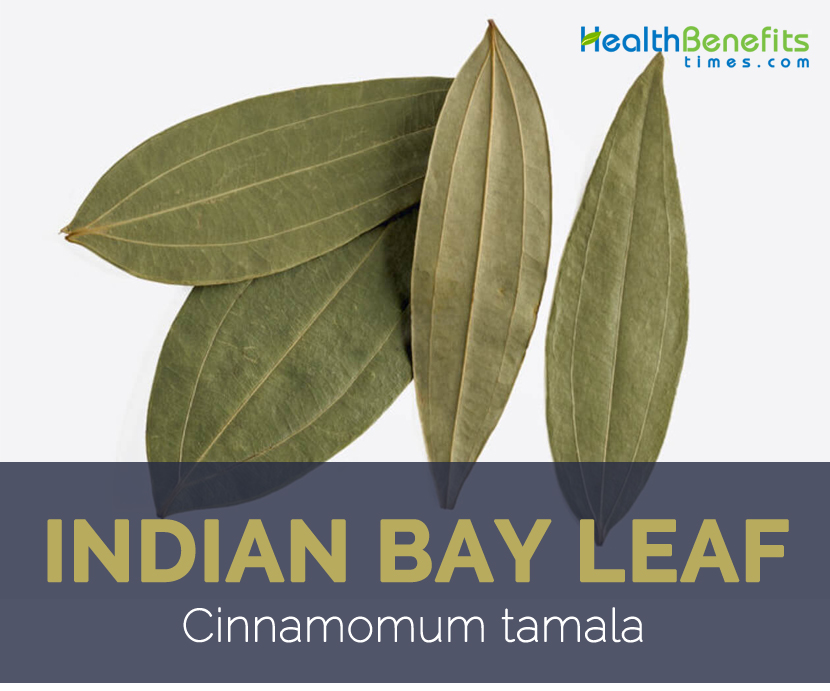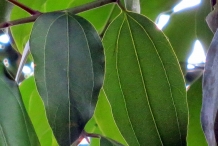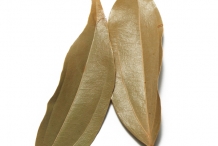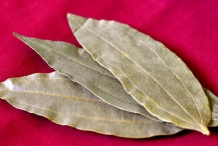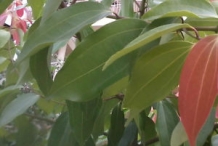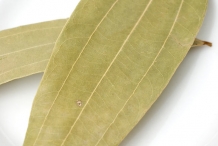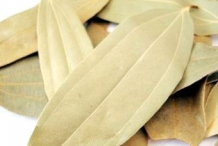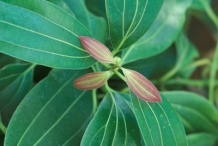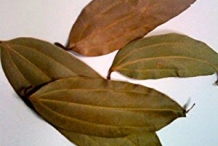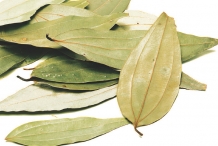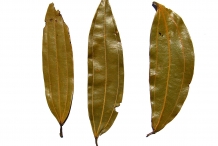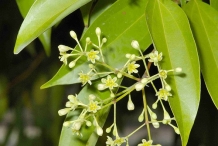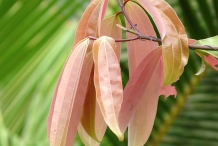| Indian Bay Leaf Quick Facts |
| Name: |
Indian Bay Leaf |
| Scientific Name: |
Cinnamomum tamala |
| Origin |
India, Bangladesh, Nepal, Bhutan, and China |
| Colors |
Black |
| Shapes |
Ovoid drupe, and succulent |
| Taste |
Sharp, bitter taste (Leaf) |
| Calories |
313 Kcal./cup |
| Major nutrients |
Iron (537.50%)
Manganese (355.09%)
Vitamin B6 (133.85%)
Calcium (83.40%)
Total dietary Fiber (69.21%)
|
| Health benefits |
Treatment of Diabetes, Beneficial during Periconception Period, Good for Digestion, Relieves Pain, Anti-cancer Properties, Treatment of Menstrual Problems, Clean Teeth, Insect Repellent, Treatment of Kidney Problems, Treatment of Cold and Infection, Induces Sleep, Treatment of Nosebleed, Cardiovascular Benefits |
Cinnamomum tamala commonly known as Indian bay leaf is a medium sized evergreen tree 2-10 m tall, found wild in the tropical and subtropical Himalayas at altitudes of 900-2500m, the Khasi hills, the nilgiri hills and at the foot of the Sikkim Himalayas. It is native to India, Nepal and Bhutan. It is commonly known as Tejpatta in Hindi, Masala Aku in Telugu, Birinji Ilai in Tamil, Karuvaela in Malayalam, Paththa in Kannada, Tej Patha in Bengali, Tamal Patr in Gujarati, Tamal Patra in Marathi, Tezpatta in Punjabi. Bay leaf is an aromatic leaf most widely used in cooking and preparing perfumes. The Indian bay leaf is basically a three veined leaf which is elliptical, pointed, smooth and tough.
Apart from Indian Bay leaf it is also known as Indian cassia, Indian cassia bark, Tamala cassia, Tejpat (India), Cassia Vera and Indian Bark. They are used in fresh, dried or powdered form. The oil extracted from bay leaves, called bay leaf oil has medicinal properties and is used to treat several ailments. Bay leaf is extensively used in Indian, Nepalese and Bhutanese cuisines. It is an important spice in Moghulai dishes, mainly biryani and korma. Roasted and ground bay leaves are added to the Indian mixture of spices called “Garam Masala”. Myrcene, which is a component of essential oils extracted from bay leaves, is used in perfumery. They also have the property of repelling flies, moths, mice etc. Apart from their culinary uses, they have medicinal properties and are known for their anti-bacterial, anti-fungal, anti-inflammatory, diuretic and astringent qualities.
Nutritional Value
Apart from their wonderful benefits, Indian Bay Leaf is a good source of nutrients, vitamins and minerals. Using 100 gram of Indian Bay Leaf offers 43 mg of Iron, 8.167 mg of Manganese, 1.74 mg of Vitamin B6, 834 mg of Calcium, 26.3 g of Total dietary Fiber, 74.97 g of Carbohydrate, 46.5 mg of Vitamin C, 0.416 mg of Copper,180 µg of Vitamin B9 and 3.7 mg of Zinc.
Types of Bay Leaves
These aromatic leaves belong to a variety of plants from different genera. Some of the common varieties of bay leaves are as follows.
1. Bay laurel (Laurus nobilis lauraceae): Also known as Mediterranean bay leaves, these leaves are used in both their fresh and dried forms to flavor soups, stews, braises etc. in Mediterranean cuisine. The fresh leaves have a milder flavor and they take several weeks after drying and picking to develop their full flavor.
2. California Bay Leaf (Umbellularia californica): Also known as California laurel, pepperwood and Oregon myrtle, this variety is similar to the Mediterranean bay laurel but has a stronger flavor.
3. Indian Bay Leaf (Cinnamomum tamala, Lauraceae): Indian Bay leaf or malabathrum is somewhat similar in appearance to bay laurel but has a taste and fragrance similar to cinnamon bark which is slightly milder.
4. Indonesian Bay Leaf or Indonesian laurel (Salam leaf, Syzgium polyanthum, Myrtaceae): Native to Indonesia, this herb is mostly used for meats and less often for vegetables.
5. West Indian Bay Leaf (Pimenta racemosa, Myrtaceae): This variety is mostly used to produce cologne called bay rum.
Health Benefits of Indian Bay Leaf
Bay leaves contain notable plant-derived compounds, vitamins and minerals which offer a range of benefits. This herb was widely used by the Greeks and Romans who believed that it symbolizes wisdom, peace and protection. The various bay leaf health benefits are given below.
1. Treatment of Diabetes
Bay leaves have been found to be effective in treating type 2 diabetes as they cause reduction in blood glucose, cholesterol and triglyceride levels. To get maximum results, these leaves can be powdered and consumed for 30 days. This will cause a drop in sugar levels in the body as well as regulate the functioning of your heart. This is because the antioxidants in bay leaf enable the body to process insulin more efficiently, thus making it a good choice for diabetics and people with insulin resistance.
2. Beneficial during Periconception Period
Being rich in folic acid, bay leaves are extremely beneficial during the periconception period (3 months before and after pregnancy).By providing adequate folic acid content to the child; they prevent birth defects in the child. These leaves also have the property of inducing pregnancy.
3. Good for Digestion
Bay leaves are good for promoting digestion and can treat digestive disorders such as heartburn and flatulence. Drinking a concoction of bay leaf tea with hot water can alleviate common digestive disorders like constipation, acid reflux and irregular bowel movements. It contains enzymes that enable the breakdown of proteins, thus making it an excellent spice for non-vegetarian diets. In case of indigestion and bloating, you can take 5 grams of bay leaves, add a piece of ginger and boil this in 200 mil of water till ¼ water remains. Add some honey and consume this twice a day for relief. It also acts as an appetite stimulant if you are recovering from illness.
4. Relieves Pain
The oil extracted from bay leaf has got anti-inflammatory properties which ease the pain resulting from sprains, strains, arthritis, rheumatism as well as general pains and aches. Massaging your temples with bay leaf oil helps to relieve migraines and headaches. Apart from that it boosts circulation and promotes a feeling of well-being. In case of joint pain, you can make a poultice of ground bay leaves and castor leaves, and tie it around the inflamed joints to reduce pain and swelling. In case of headache, you can boil a few bay leaves in water for a few minutes. Strain and drink this concoction while it is still hot. You can apply a paste of bay leaves on your forehead to get relief from severe headache.
5. Anti-cancer Properties
Bay leaf contains caffeic acid, quercetin, euganol and catechins all of which have chemo-protective properties which offer resistance against different types of cancer. They also contain a phytonutrient called parthenolide which has shown to specifically restrain the proliferation of cervical cancer cells.
6. Treatment of Menstrual Problems
Bay leaves, when taken orally, help to induce regular and normal menstruation. They also have the property of curing vaginal discharge.
7. Clean Teeth
To get sparkling white teeth, brush them with powdered bay leaves once in 3 days.
8. Insect Repellent
Bay leaves are a great insect repellent as they contain lauric acid. A dish of bay leaves will ward off insects. A paste made from crushed leaves and little oil relieves stings and bites when applied topically.
9. Treatment of Kidney Problems
Bay leaves help in treating kidney infections and even kidney stones. For this purpose, boil 5 grams bay leaves in 200 ml water till 50 ml water remains. Strain and drink this twice daily. This will stop the formation of kidney stones.
10. Treatment of Cold and Infection
Bay leaves are effective in fighting the symptoms of cold, flu and infections. In case of respiratory problems, boil water and add 2 to 3 bay leaves. Allow it to steam for 10 minutes. Soak a cloth in this water and place it on your chest to alleviate flu, cold and cough. Bay leaf tea is effective in reducing fever. In case of repeated sneezing, boil some bay leaves in 200 ml water till ¼ remains. Strain and drink this concoction.
11. Induces Sleep
Consuming bay leaves at bedtime helps to encourage proper sleep. For this purpose, mix a few drops of the bay leaf extract with water and consume it.
12. Treatment of Nosebleed
In case of nosebleed, crush 2 to 3 fresh or dry bay leaves. Boil them in 200 ml water till 100 ml remains. Strain and drink this concoction for relief.
13. Cardiovascular Benefits
The powerful phytonutrients in bay leaf provide protection against cardiovascular diseases such as heart attacks and strokes. They contain valuable compounds such as rutin, salicylates, caffeic acid and phytonutrients which help to boost heart health and improve heart function. In case of heart disease and anxiety, boil 3 grams of bay leaves and 3-4 grams of wild rose flowers in 300 ml water till only 75 ml remains. Strain and drink this concoction for relief.
Bay Leaf Skin Benefits
Being rich in vitamins, minerals and antioxidants, bay leaf offers various benefits to your skin and has been used in herbal medicine for this purpose. Some of its skin benefits are as follows.
1. Relieves Stressed Skin
Bay leaf helps to de-stress your skin, thus preventing the occurrence of wrinkles and skin outbreaks. For this purpose, boil 5 dried bay leaves with 2 cups of water, keeping the container covered. Then remove the lid and let it boil for about 2 minutes. Now pour the brew into a large bowl and covering your head with a towel, inhale this steam.
2. Healing Qualities
Bay leaf has excellent healing properties. It is often used by herbal practitioners for treating snakebite, insect stings and relieving cuts and bruises. Bay leaf oil has antifungal and anti-bacterial properties which can cure skin infections. It is applied topically to heal cuts, bruises and insect bites.
Bay Leaf Hair Benefits
The nutritional value of bay leaves makes them beneficial for hair health. It has the following benefits for your hair.
1. Treatment of Dandruff and Hair Loss
A rinse made from infused bay leaves is effective in treating dandruff. Bay leaf tea is considered a great remedy for hair loss. Bay leaf oil is a tonic for hair that efficiently combats dandruff and hair loss.
2. Treatment of Head Lice
For getting rid of head lice, boil about 50 grams of crushed bay leaves in 400 ml water until 100 ml water remains. Strain out the water and apply this on the hair roots. Leave it for 3 to 4 hours and wash off. This will remove the head lice effectively. Adding Bhringraj to the bay leaves before boiling will make your hair black, lustrous and healthy.
Ayurvedic Benefits of Indian Bay-leaf
- Cold, cough, Coryza, Allergy, Sinusitis: Prepare tea of bay leaves (3-4), Tulsi leaves, and Black pepper. Drink thrice a day. You may add honey as per taste.
- Headache due to cold: Prepare decoction of bay leaves and drink few times a day.
- Scalp infection, lice in hairs: Prepare decoction by boiling bay leaves (5 gm.) in water (400 ml) till volume reduces to 100 ml. Filter and use this decoction, apply in roots of hair. Leave for 3 hours then wash with plain water. You may add Bringraj in it to make hair black and strong.
- Coughing: Take powder of bay leaves (2 gm.) with honey.
- Asthma, Respiratory problems: Take bay leaves (5 gm.), liquorice (2 gm.), Pippali (1 gm.) or sonth (1 gm.). Prepare decoction in 200 ml water till volume reduces to 50 ml. Filter and drink.
- Abdominal pain, Abdominal gas, Indigestion, Nausea, vomiting: Prepare decoction by boiling bay leaves (5 gm.), ginger in water (400 ml) till volume reduces to 100 ml. Filter and drink twice or thrice a day.
- Heart diseases, Angina, Uneasiness, Palpitation: Prepare decoction by boiling bay leaves (3 gm.), Rose petals (3 gm.), clove (3) in water (300 ml) till volume reduces to one forth. Filter and drink twice or thrice a day.
- Arthritis, Joint pain, Gout, Inflammation: Warm bay leaves and Castor leaves and apply at affected area.
- Coughs & Colds: Placing a cloth soaked in water in which bay leaves have been boiled provides relief from cough, cold, bronchitis and chest infections.
- Aches & Pains: Essential oil of bay leaf is massaged on sprained areas and for relieving headaches. The oil also provides relief from swellings, rheumatic and arthritic pain.
- Fever: Bay leaves infusion promotes sweating, breaking fever, and flu symptoms.
- Digestion: Bay leaves are used for treatment of digestive disorders. They reduce flatulence.
- Treatment of Nosebleed: In case of nosebleed, crush 2 to 3 fresh or dry bay leaves. Boil them in 200 ml water till 100 ml remains. Strain and drink this concoction for relief.
- Treatment of Kidney Problems: Bay leaves help in treating kidney infections and even kidney stones. Boil 5 grams bay leaves in 200 ml water till 50 ml water remains. Strain and drink this twice daily. This will stop the formation of kidney stones.
- Insect Repellent: Bay leaves are a great insect repellent as they contain lauric acid. A dish of bay leaves will ward off insects. A paste made from crushed leaves and little oil relieves stings and bites when applied topically.
- Induces Sleep: Consuming bay leaves before going to the bed induces sleep. Mix few drops bay leaf extract in water and drink it for best results.
- Cardiovascular Benefits: The compounds present in bay leaf boosts heart health and prevent heart attack and strokes. Drinking water with bay leaf extract avoids all types of heart complications.
- Skin Toner: Boil 4 bay leaves in a cup of water. Strain the solution and add two tablespoons of rose water to it. Transfer the solution into a spray bottle and store it in the refrigerator. Spritz your face with the solution twice a day and get better results.
Indian Bay Leaf Facts
Bay leaves popularly known as Tej patta, does more than add a tinge of flavor and aroma to your food. But, sadly not many of us are aware of the health benefits of this wonder herb. It is loaded with essential vitamins, minerals and antioxidants that can literally transform the way your skin and hair feels. It treats several ailments and is anti-bacterial, antifungal and anti-inflammatory in nature. It is also rich in antioxidants and flavonoids. This honorable spice is also a good source of minerals, like Copper, Potassium, Calcium, Manganese, Selenium and Iron.
| Name |
Indian Bay-leaf |
| Scientific Name |
Cinnamomum tamala |
| Native |
India, Bangladesh, Nepal, Bhutan, and China |
| Common Names |
Indian bay leaf, tejpat, tejapatta, Malabar leaf, Indian bark, Indian cassia, malabathrum |
| Name in Other Languages |
German: Indisches Lorbeerblatt
Arabic: Zarnab
Assamese: Mahpat, Tējapāta (তেজপাত) Tej pat, Tezpat
Bengali: Tējapāta (তেজপাত) Tejpata, Tezpata
Burmese: Maza, Shing nam, Thikya bo, Thitchabo
Chinese: La pi shu, Chai gui (柴 桂 ), Sāngǔ jīn (三股筋), Guìpí(桂皮), Ròuguì( 肉桂), Là pí shù (辣皮树)
Danish: Indisk Laurbærblad
English: Indian Bay-leaf, Indian cassia, Indian cassia bark, Tamala cassia, Tejpat (India), Cassia Vera, Indian Bark
Esperanto: Hinda cinamomo
Finnish: Kanelilaakeri
French: Laurier des Indes
German: Indisches Lorbeerblatt
Gujarati: Tamālapatra (તમાલપત્ર) Tamaal patra, Tamala patra
Hindi: Tejapatta (तेजपत्ता) Tejpata (leaves), Tejpatta, daalacheenee (दालचीनी) Dalchini (bark)
Hungarian: Indiai babérlevél
Japanese: Ta maranikkei( タ マラニッケイ) Tamara Nikkei, Tamara-nikkei, Tezipatto, Tejipatto(テジパット)
Kannada: Patraka, Tamalapatra, Dalchini Ele
Kashmiri: Dalchini pan, Tajpatra
Latin: Cortex Malabathri, Folia Malabathri
Lithuanian: Indinis cinamonas
Malayalam: Tamālapatram (തമാലപത്രമ്), Karuvaela
Marathi: Tamaal patra(तमाल पत्र ), Tamalapatra
Nepalese: Shisii, Tejapaat
Oriya: Tejpatra
Punjabi: Tejpatra
Russian: Indiyskiy lavr Indiiskii lavr (Индийский лавр Indiiskii lavr), Korichnik gimalaiskii (Коричник гималайский), Korichnik tamala (Коричник тамала), Koritsa malabarskaia (Корица малабарская) , Malabarskaia koritsa (Малабарская корица), Malabarskij korichnik (Малабарский коричник), Malabarskij list (leaf), (Малабарский лист), Malabarskaya koritsa, Malabarskaâ korica
Sanskrit: तमालपत्त्र Tamalapattra, Tamalpatra, Tejpatra, tamalaka, Tejapatra
Tamil: Tāḷicappattiri (தாளிசபத்திரி), Talishappattiri, Birinji IIai
Telugu: Talisapatri, Talisha, Tallishapatri, Patta akulu, Masala Aku
Thai: Kæng(แกง) Kaeng (Chiang Mai), Xbchey t̂n(อบเชยต้น) Op choei ton, Ob choey tan,
Urdu: Tejpat
Unani: Saleekhaa, Saazaj Hindi Also equated with Zarnab/Telispattar
Vietnamese: ô duoc |
| Plant Growth Habit |
Medium sized evergreen tree |
| Plant Size |
20 m (66 ft.) tall |
| Leaf |
Simple, short stalked, leathery, ovate, lanceolate, long pointed 10- 15 cm long with 3 conspicuous nearly parallel veins arising from near the base, bright pink when young in spring, aromatic when crushed. |
| Flower |
Pale yellow, in terminal and axillary-branched clusters |
| Fruit Shape & Size |
Ovoid drupe, and succulent |
| Fruit Color |
Black |
| Leaf Color |
Olive green color |
| Flavor/Aroma |
Herbal and floral |
| Taste |
Sharp, bitter taste |
| Plant Parts Used |
Bark & leaf |
| Varieties |
- Bay laurel
- California Bay Leaf
- Indian Bay Leaf
- Indonesian Bay Leaf or Indonesian laurel
- West Indian Bay Leaf
|
| Major Nutrition |
Iron, Fe 43 mg (537.50%)
Manganese, Mn 8.167 mg (355.09%)
Vitamin B6 (Pyridoxine) 1.74 mg (133.85%)
Calcium, Ca 834 mg (83.40%)
Total dietary Fiber 26.3 g (69.21%)
Carbohydrate 74.97 g (57.67%)
Vitamin C (Ascorbic acid) 46.5 mg (51.67%)
Copper, Cu 0.416 mg (46.22%)
Vitamin B9 (Folate) 180 µg (45.00%)
Zinc, Zn 3.7 mg (33.64%)
Vitamin B2 (Riboflavin) 0.421 mg (32.38%)
Magnesium, Mg 120 mg (28.57%)
Total Fat (lipid) 8.36 g (23.89%)
Phosphorus, P 113 mg (16.14%)
Protein 7.61 g (15.22%)
Vitamin B3 (Niacin) 2.005 mg (12.53%)
Potassium, K 529 mg (11.26%)
Selenium, Se 2.8 µg (5.09%)
Sodium, Na 23 mg (1.53%) |
| Health Benefits |
- Treatment of Diabetes
- Beneficial during Periconception Period
- Good for Digestion
- Relieves Pain
- Anti-cancer Properties
- Treatment of Menstrual Problems
- Clean Teeth
- Insect Repellent
- Treatment of Kidney Problems
- Treatment of Cold and Infection
- Induces Sleep
- Treatment of Nosebleed
- Cardiovascular Benefits
|
| Calories in (100 gm) |
313 Kcal |
| Traditional Medicinal Benefits |
- Leaf is used in rheumatism, colic, diarrhea and in scorpion sting.
- It is useful in the treatment of high blood sugar, migraine, headaches, gastric ulcers, rheumatism, colic, amenorrhea and a lot of other health conditions.
- Indian bay leaf is an important ingredient in Ayurvedic tea which is used for treating coughs and colds.
- For problems like cough, cold, excess mucus, allergy and other respiratory problems etc., crush 3-4 bay leaves, add 1-2 Tulsi (holy basil) leaves and boil this in about 250 ml water. Cool, strain and drink this while still tolerably warm.
- For headache, even severe headache, boil a few bay leaves in water for a few minutes. Strain, cool a bit and drink while still hot. Also apply a paste of bay leaves on the forehead for relief from severe headache.
- For getting rid of head lice, take about 50 grams of crushed dry bay leaves and boil in 400 ml water. Remove when the water is about 100 ml remaining. Apply this on the hair roots after straining out the water. Let it remain for 3-4 hours then wash. This removes the lice.
- If Bhringraj is added to the bay leaves before boiling, it will make the hair black, lustrous and healthy.
- In respiratory diseases like asthma etc., add 2 grams Mulethi (liquorice) and 1 gram Pippali or dry ginger powder to 5 grams of bay leaves and boil in 200 ml water till 100 ml water remains. Strain and drink. It boosts body immunity and cures conditions like cough, asthma and other respiratory problems.
- For cough, take 1-2 grams of powdered dry bay leaves mixed with a tsp of honey twice a day. It is very effective in stopping cough.
- Those who suffer from indigestion and bloating or any other digestive problem can take 5 grams of bay leaves, add a piece of ginger and boil this in 200 ml of water till 1/4 water remains. Add a spoonful of honey and consume twice a day for relief.
- For kidney problems, kidney infections and even for kidney stone, boil 5 grams bay leaves in 200 ml water till 50 ml water remains. Strain and drink 2 times daily. This stops formation of kidney stones also.
- For heart disease and anxiety, take 3 grams of bay leaves and 3-4 grams of Desi (wild) rose flowers. Add to 300 ml water and boil till only 75 ml remains. Strain and drink for relief.
- If there is angina pain, add 2 cloves to the above and then boil the water. It stops angina pain.
- For uterus problems like infection, etc., which mostly occur after childbirth, take a few grams each of the bark of the bay leaf tree, bay leaf, carom seeds and dry ginger powder. Boil these in 200 ml water and drink twice a day. This clears the infection and tones the uterus.
- Repeated sneezing shows that the body’s internal functioning is not very right. To set it right, boil some bay leaves in 200 ml water till 1/4 water remains. Strain and drink.
- To relieve joint pains, make a poultice of ground bay leaves and arund (castor) leaves. Tie it around the inflamed joint. It relieves pain and swelling.
- For nosebleed, crush 2-3 fresh or dry bay leaves. Add to 200 ml water and boil till 100 ml remains. Strain and drink for relief.
- For clean teeth, brush with powdered bay leaves once in 3 days. It will make the teeth sparkle.
|
| Culinary Uses |
- It has aromatic leaves which are used for culinary and medicinal purposes.
- The bark is also sometimes used for cooking, although it is regarded as inferior to true cinnamon or cassia.
- Bay leaf is used as a spice to impart flavor to a variety of dishes of various cuisines around the world, both vegetarian and non-vegetarian.
- The leaf is used for flavoring stews, dishes that need a long time to cook and soups.
|
| Other Facts |
- It is one of the constituents of the Indian Garam masala – a mixture of spices.
- Bay leaves also have the property of repelling flies, moths, roaches, mice etc.
- The flowers of this plant are also used in folk medicine.
|
| Precautions |
- The dosage more than 1 gram per day may induce sweating and dieresis in some people.
|
References:
https://en.wikipedia.org/wiki/Cinnamomum_tamala
http://www.gbif.org/species/3033986/vernaculars
http://www.plantnames.unimelb.edu.au/Sorting/Cinnamomum.html
https://www.itis.gov/servlet/SingleRpt/SingleRpt?search_topic=TSN&search_value=506207#null
http://davesgarden.com/guides/pf/go/192563/
https://npgsweb.ars-grin.gov/gringlobal/taxonomydetail.aspx?400140
http://nationalorganics.com.np/Cinnamomum-tamala
http://www.herbwisdom.com/herb-bay.html
http://www.openaccessscience.com/pdf-files/vol1_1_june2011/IJMAP_1_1_1_Cinnamomum%20tamala.pdf
https://hero.epa.gov/hero/index.cfm/reference/details/reference_id/1136325
http://www.openaccessscience.com/pdf-files/vol1_1_june2011/IJMAP_1_1_1_Cinnamomum%20tamala.pdf
Comments
comments


